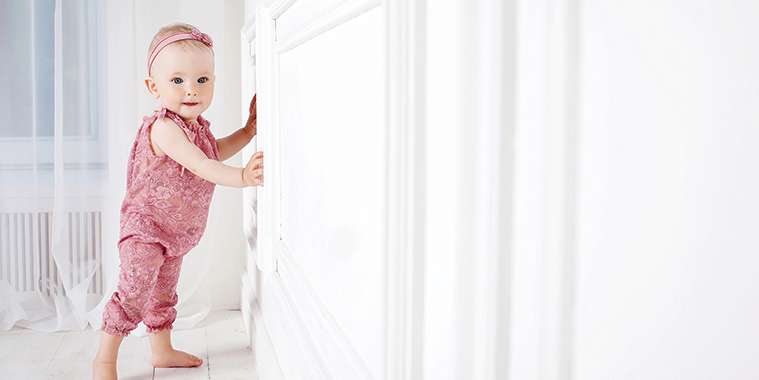Bringing a baby home is wonderful. And terrifying. Suddenly that Mid-Century Modern coffee table you just had to have seems so very pointy and just the right height to put an eye out. And all those succulent planters? You just know your little tyke is going to pull those down and get hurt. All of this makes baby-proofing your home a must, hopefully before your bundle of joy starts toddling around. But how far do you really have to go to keep your home from killing your kid?
It turns out you really aren’t overreacting. Every year, millions of kids are hospitalized because of accidents around the home, according to Safe Kids Worldwide. But there’s good news: You can easily lower those odds by thoroughly baby-proofing your home. Here are the steps you need to take to keep baby safe.
Is your baby furniture safe?
First things first: Check the Consumer Product Safety Commission site for any recent recalls that might include stuff you’ve bought. While widespread recalls are fairly rare, you can sign up for notifications by email or phone so you don’t have to worry. You’d be amazed by how many products have been recalled that are still in parents’ homes, particularly since used baby furniture is often sold secondhand to others. So, be sure to check any furniture you bring into your home, from drop-side cribs (bad idea) to baby bumpers (anything in a crib is a suffocation hazard) to rickety high chairs that tip over.
How to spot trouble
To truly baby-proof a home, you must think like a baby.
“The first thing I always recommend new parents do is to get down on your hands and knees and look around the room from a baby’s perspective,” says Jen Taylor, founder of the new-mom survival guide, MomTricks. “It may feel silly, but you’ll be able to get a much better idea of what might be dangerous to a curious toddler.”
Keep an eye out for anything pointy, slippery, or potentially dangerous. Any serious risks might need to be removed (or at least covered up) until baby is a bit taller. For furniture with sharp edges, invest in some bumpers. They won’t look great, but neither does a baby with a black eye.
Safe paint for your nursery
Whether you pick pink, blue, yellow, or some other pastel shade for the walls of your nursery, look to buy products that have low or no VOCs. Volatile organic compounds are microscopic particles that waft off of many paints, wood stains, varnishes, rugs and furniture. Though tiny, they can cause short- and long-term health effects like nose and throat irritation, headaches, dizziness, or liver and kidney damage.
Alternatives like milk-based paints (no, seriously) from Real Milk Paint are VOC-free, have a low mold growth, and are environmentally friendly. And don’t forget, if you’re stripping the old paint or wallpaper, skip the chemical-laden stuff and opt for a healthier alternative like a soy-based paint remover.
Lock it down
Toddlers are notoriously curious. Turn your back for a second, and they’re getting into something. To keep your home safe, you’ll have to lock everything down — and we do mean everything.
For cabinets and drawers, look for the simple plastic latch that attaches to the tops and that must be bent down to open. It’ll keep those cabinets off-limits without driving you crazy every time you need to grab something.
For doors, it may be enough just to make sure your toddler can’t reach the lock — and you’re motivated enough to keep it locked all the time. If you’re not sure, Taylor recommends the Child Proof Deluxe Door Top Lock. Unlike regular door guards that lock from the bottom (where a toddler might figure out how to defeat it), this one locks from the top where only the grown-ups can reach. And it is simple enough that you won’t be stuck fiddling with it every time you need to get out.
Reduce hazards
Check around your home for loose cords or wires. Curtain pulls and electrical cords in particular can be a problem and should be tucked away or tied down securely. Also make sure electrical outlets are covered lest your curious child starts poking around and gets the shock of his life.
Taylor recommends the LectraLock electrical outlet covers. “Instead of blocking off the outlet entirely, they let you use the outlets while keeping the plugs secured so that they can’t be pulled out,” she says.
Clean and clean again
Even with everything locked down and secured, you’re still going to face one big obstacle: “Assume anything that’s not nailed down is going to end up in their mouth,” Taylor says. “That means being ever-vigilant and not missing anything that might fall on the floor, be it food or otherwise. Even the smallest of objects can be a choking hazard.”
To keep things hazard-free, you’ll need to create and stick to a pretty regular cleaning schedule. Check the floors often for anything that might have dropped and keep an eye out for stuff that slides under the furniture. Sound like a pain? It is. It might be time to invest in that Roomba.
But in the end, remember the golden truth: “Don’t drive yourself crazy with worry,” Taylor says. “You’ll have to be OK with bumps and bruises. They’re going to happen. But seriously, never underestimate a toddler’s ability to get into things they shouldn’t be getting into.”
— realtor.com



